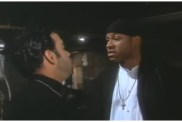A South by Southwest review

Cast:
Amanda Fuller as Erica
Noah Taylor as Nate
Marc Senter as Franki
Directed by Simon Rumley
Review:
For genre fans, reactions to films at non-genre film festivals can be remarkably unreliable; occasionally, really great smaller or off-the-radar flicks start their meteoric rise to cult adoration via a buzzed-about festival screening, but typically these movies are crappy and uninspired, offering nothing more than half-assed ideas executed in the quickest and cheapest ways possible. All of which is why Simon Rumley’s Red White & Blue, which screened Saturday at Austin’s South By Southwest Film Festival, is even more of a welcome surprise.
With his follow-up to the cult 2006 effort The Living and the Dead, writer-director Rumley has made a startling, incredibly powerful film, a terrifying portrait of brutality, and a sensitive character study all at once. Simultaneously lyrical and disturbing, violent and restrained, Red White & Blue would be the kind of film that could legitimize the artistic integrity of oft-reduced subgenres like “torture porn” if they weren’t already mired in gratuitous visual and storytelling clichés, but it’s enough that it should be high on horror fans’ priority lists when it hopefully finds wider distribution later this year.
The film stars Amanda Fuller as Erica, a melancholy Austin native whose life ambition appears to be sleeping her way through the town’s male population. After an Iraq war veteran named Nate (Noah Taylor) shows an interest in more than her body, a tenuous relationship evolves between the two of them, and her coldly indifferent façade slowly begins to melt. But when one of Erica’s former conquests named Frankie (Marc Senter) returns to her life bearing some particularly bad news, Erica’s newfound happiness quickly descends into a spiral of violence and retribution that affects all three of them.
Rumley has described Red White & Blue saying that “it’s not so much a horror film as it is a terror film,” and although gorehounds will be duly satisfied with its final moments, the director shows a restraint that feels more disturbing precisely because it’s less graphic. While some of the reception at SXSW was admittedly mixed (rumor has it that a post-screening Q&A on another night devolved into a shouting match when an audience member asked what was the point of making the film), horror fans will recognize immediately that even if the amount of violence shown in the film has questionable purpose, all of it has real motivation, and it’s this narrow distinction that elevates the material above the realm of sheer, pointless exploitation.
Indeed, the film devotes the vast majority of its running time not only to introducing these three characters, but deeply humanizing them so that we understand who they are and what they’re doing. Because Rumley uses his three-act structure to essentially offer three different stories that dovetail into one another, we spend a significant time with Erica, Nate and Frankie, and quickly find ourselves re-evaluating our first (and second and third) impressions of them as each one’s behavior impacts that of the others. That the writer-director manages to do so much nonverbally is further testament to the effectiveness of his abilities as a storyteller, but what proves most surprising, and ultimately, gratifying, is the completeness of the three characters at the center of this devastating tale.
Further, it’s tough to say who has to do the film’s heaviest lifting, given the variety of challenges each actor faces in his or her respective role, but all three bring their characters to brilliant life. As Erica, Fuller is fearless both physically and emotionally, revealing the slow and subtle ways that the character’s callused exterior softens when she meets someone who isn’t exclusively interested in seeing her naked. Meanwhile as Frankie, Senter turns the visage of a white-trash douchebag into something much more substantial, and even sympathetic, showing how the character’s naïve spontaneity is sometimes helpful, sometimes hurtful, but always sincere, and most of all, self-aware.
And finally as Nate, Noah Taylor’s scruffy beard and intense stillness does much of the work making him both tender and threatening, but the actor expertly finds the razor’s edge where Nate’s sociopath personality dances between low-key suitor and just plain guy you don’t want to f*ck with. The explosive interplay of the characters is obviously what intensifies the film’s dramatic momentum, but these three are more than game to go from sublime to mundane in the service of playing their roles, making even their most unexpected behavior seem naturalistic, and more impressively, understandable.
Admittedly, it’s tough to talk about the film’s bloodier moments without ruining the surprise of how they end up happening. But suffice it to say that unlike retconned remakes or thrillers that try to put you inside the heads of homicidal, weapon-wielding monsters, Red White & Blue succeeds because it shows you the devastating violence that can be wrought against others, as well as the depths of humanity â rather than some simplistic portrait of “evilâ – that its perpetrator can possess. Ultimately, the carnage in Rumley’s film may not be for everyone, but its characters reveal how with a little bit of understanding, we can relate to anyone â all of which is why Red White & Blue is the exceptional festival entry that proves the rule: it’s truly harrowing, rather than merely being just another horror film.










